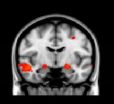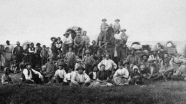(Press-News.org) The area of the brain that plays a primary role in emotional learning and the acquisition of fear – the amygdala – may hold the key to who is most vulnerable to post-traumatic stress disorder.
Researchers at the University of Washington, Boston Children's Hospital, Harvard Medical School and Boston University collaborated on a unique opportunity to study whether patterns of brain activity predict teenagers' response to a terrorist attack.
The team had already performed brain scans on Boston-area adolescents for a study on childhood trauma. Then in April 2013 two bombs went off at the finish line of the Boston Marathon, killing three people and injuring hundreds more. Even people who were nowhere near the bombing reported distress about the attack and the days-long manhunt for the suspects.
So, one month after the attack, Katie McLaughlin, then at Boston Children's Hospital and Harvard Medical School and now an assistant professor of psychology at the UW; co-author Margaret Sheridan, of Boston Children's Hospital and Harvard Medical School; and their fellow researchers sent online surveys to teenagers who had previously participated in studies to assess PTSD symptoms related to the attack.
By using functional Magnetic Resonance Imaging scans from before the attack and survey data from after, the researchers found that heightened amygdala reaction to negative emotional stimuli was a risk factor for later developing symptoms of PTSD.
The research study was published July 3 in the journal Depression and Anxiety.
"The amygdala responds to both negative and positive stimuli, but it's particularly attuned to identifying potential threats in the environment," said McLaughlin, the study's first author. "In the current study of adolescents the more their amygdala responded to negative images, the more likely they were to have symptoms of PTSD following the terrorist attacks."
The brain scans were conducted during the year prior to the bombing. At that time, the teens were evaluated for their responses to emotional stimuli by viewing neutral and negative images. Neutral images included items such as a chair or button. Negative images showed people who were sad, fighting or threatening someone else. Participants rated the degree of emotion they felt while looking at each image. The MRIs measured whether blood flow increased to the amygdala and the hippocampus when viewing negative images as compared to neutral images.
In the follow-up survey the teens were asked whether they were at the finish line during the bombing, how much media exposure they had after the attack, whether they were part of the lockdown at home or school while authorities searched for the suspects, and how their parents responded to the incident. They also were asked about specific PTSD symptoms, such as how often they had trouble concentrating and whether they kept thinking about the bombing when they tried not to.
Researchers found a significant association between amygdala activation while viewing negative images and whether the teens developed PTSD symptoms after the bombing.
McLaughlin said a number of previous studies have shown that people with PTSD had heightened amygdala responses to negative emotions, but researchers didn't know whether that came before or after the trauma.
"It's often really difficult to collect neurobiological markers before a traumatic event has occurred," she said. By scanning the adolescents' brains before the bombing, she and her fellow researchers were able to show that "amygdala reactivity before a traumatic event predicts your response to that traumatic event."
While two-thirds of Americans will be exposed to some kind of traumatic event during their lifetime, most, fortunately, will not develop PTSD.
"The more we understand the underlying neurobiological systems that shape reactions to traumatic events, the closer we move to understanding a person's increased vulnerability to them," McLaughlin said. "That could help us develop early interventions to help people who might develop PTSD later."
INFORMATION:
Other co-authors are Andrea Duys, of UW; Daniel Busso and Sonia Alves at Harvard; and Jennifer Greif Green at Boston University. The research was funded by the National Institutes of Health.
For more information, contact McLaughlin at mclaughk@uw.edu or 206-616-7863. To reach Sheridan, contact Meghan Weber at 617-919-3656 or meghan.weber@childrens.harvard.edu.
NIH grants: K01-MH092526 and K01-MH092555.
Link to research study: http://onlinelibrary.wiley.com/doi/10.1002/da.22284/abstract
Brain responses to emotional images predict PTSD symptoms after Boston Marathon bombing
2014-07-15
ELSE PRESS RELEASES FROM THIS DATE:
Study finds unintended consequences of raising state math, science graduation requirements
2014-07-15
WASHINGTON, D.C., July 15, 2014 ─ Raising state-mandated math and science course graduation requirements (CGRs) may increase high school dropout rates without a meaningful effect on college enrollment or degree attainment, according to new research published in Educational Researcher (ER), a peer-reviewed journal of the American Educational Research Association.
VIDEO: Co-authors Andrew D. Plunk and William F. Tate discuss key findings. https://www.youtube.com/watch?v=jwxh1gj-T1M&feature=youtu.be
"Intended and Unintended Effects of State-Mandated High School ...
BUSM study: Obesity may be impacted by stress
2014-07-15
Using experimental models, researchers at Boston University School of Medicine (BUSM) showed that adenosine, a metabolite released when the body is under stress or during an inflammatory response, stops the process of adipogenesis, when adipose (fat) stem cells differentiate into adult fat cells.
Previous studies have indicated adipogenesis plays a central role in maintaining healthy fat homeostasis by properly storing fat within cells so that it does not accumulate at high levels in the bloodstream. The current findings indicate that the body's response to stress, potentially ...
Team studies immune response of Asian elephants infected with a human disease
2014-07-15
CHAMPAIGN, Ill. — Mycobacterium tuberculosis, the organism that causes tuberculosis in humans, also afflicts Asian (and occasionally other) elephants. Diagnosing and treating elephants with TB is a challenge, however, as little is known about how their immune systems respond to the infection. A new study begins to address this knowledge gap, and offers new tools for detecting and monitoring TB in captive elephants.
The study, reported in the journal Tuberculosis, is the work of researchers at the University of Illinois Zoological Pathology Program (ZPP), a division of ...
Protein's 'hands' enable bacteria to establish infection, research finds
2014-07-15
MANHATTAN — When it comes to infecting humans and animals, bacteria need a helping hand.
Kansas State University biochemists have found the helping hand: groups of tiny protein loops on the surface of cells. These loops are similar to the fingers of a hand, and by observing seven individual loops on the surface of E. coli bacterial cells, the researchers found that the loops can open or close to grab iron in the environment.
"These structures are like small hands on the surface of bacterial cells," said Phillip Klebba, principal investigator and professor and head of ...
4 lessons for effective, efficient research in health care settings
2014-07-15
Thousands of studies take place every year in healthcare settings. A report published recently in the American Journal of Preventative Medicine describes how to do many of these studies more rapidly. By taking into account the real-world constraints of the systems in which providers deliver care and patients receive it, researchers can help speed results, cut costs, and increase chances that recommendations from their findings will be implemented.
The lessons come from the My Own Health Report project, a collaboration between seven research institutions with the goal ...
Mormon pioneer mortality rate calculated at 3.5 percent
2014-07-15
The final stanza of the Mormon pioneer anthem "Come, Come Ye Saints" directly confronts the prospect of dying on the trail: "And should we die, before our journey's through…"
Now new research shows that pioneer mortality rates were not much greater than national averages at the time.
This may come as a surprise to modern Mormon youth who've participated in handcart treks.
"The youth go out and learn that a lot of people died and they push the handcart and after three days they think they are practically dead," said retired historian Mel Bashore. "But most people traveled ...
Saltier intravenous fluids reduce complications from surgery
2014-07-15
(PHILADELPHIA) -- Adequate hydration via a saline drip is essential during surgery, but recent reports suggest that getting the balance of salt and water just right could have an important impact on patient recovery. In the largest study of its kind researchers at Thomas Jefferson University found that a slightly saltier intravenous drip (hypertonic saline), and lower total volume of fluid received, reduced the overall rate of complications by 25 percent after the complex Whipple surgery for pancreatic cancer.
"This relatively minor change in intravenous fluids has ...
Defects in fatty acid transport proteins linked to schizophrenia and autism
2014-07-15
Using diverse methodologies, neuroscientists from the RIKEN Brain Science Institute report that defects in Fatty Acid Binding Proteins (FABPs) may help to explain the pathology in some cases of schizophrenia and autism spectrum disorders. After identifying mutations in FABPs from patients, the group led by Senior Team Leader Takeo Yoshikawa determined that the genetic disruption of Fabps in mice mimics disease behaviors seen in patients. This work suggests that disruption of FABPs could be a common link underlying some forms of these two prevalent mental disorders.
Published ...
Smarter ads for smartphones: When they do and don't work
2014-07-15
NEW YORK — Brands spent $8.4 billion on mobile advertising in 2013, and that number is expected to quadruple to $36 billion by 2017, according to eMarketer. But do mobile display ads — those tiny banner ads that pop up in your smartphone's web browser — actually work? Researchers at Columbia Business School have found that, despite their size, mobile ads can have a big effect on consumers who are in the market for certain types of products.
"Digital advertising in mobile channels is experiencing explosive growth," said Miklos Sarvary, co-director of the Media Program ...
NASA sees Typhoon Rammasun's eye staring at Visayas, Philippines
2014-07-15
Early on July 15, Typhoon Rammasun began making landfall in the eastern part of the central Philippines and NASA's Aqua and TRMM satellites spotted the 20 nautical-mile-wide (23 mile/37 km) eye of the storm close to landfall.
Typhoon Rammasun was making landfall in the Visayas region. Visayas is located in the central Philippines.
The Tropical Rainfall Measuring Mission or TRMM satellite passed over Rammasun on Tuesday, July 15, 2014 at 04:10 UTC (12:10 a.m. EDT) and measured rainfall occurring throughout the storm. TRMM found moderate rainfall (about 35 mm)/1.4 inches ...





